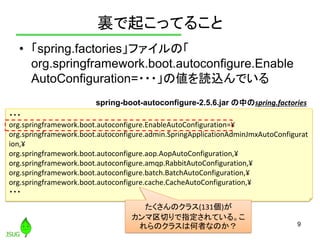Ad
怖くないSpring Bootのオートコンフィグレーション
- 2. 自己紹介 • 土岐 孝平 • 合同会社 現場指向 – Springのオンライン研修 – スポット技術支援 – メモラキー • 書籍の執筆 2 [改訂新版]Spring入門 OpenID Connect入門 「ゼロ・トゥー・ヒーロー with Spring」 ~ 5日間でゼロから即戦力へ ~ 現場指向 🔍 ☆限定割引中☆
- 3. アジェンダ • オートコンフィグレーションとは? • 仕組み • デバッグ方法 • カスタマイズ方法 3
- 4. DI コン テナ オートコンフィグレーションとは? • Spring Bootの主要な機能のひとつ • 定型的で面倒なコンフィグレーションを自動で行って くれる – ライブラリが提供するクラスのBean定義、各種機能の有 効化 4 Controller Service Dao ライブラリのクラスのBean 開発者が作成するクラスのBean ・・・ トランザクショ ンマネージャ MyBatis用の クラス データ ソース Spring MVC用の クラス この部分 トランザクション制御の 有効化 キャッシュ機能の 有効化 ・・・ プロパティファイル などで簡単に カスタマイズ可能
- 7. アジェンダ • オートコンフィグレーションの仕組み – オートコンフィグレーションの正体 – @ConditionalOnXxxアノテーション 7
- 8. オートコンフィグレーションの有効化 • @EnableAutoConfigurationをDIコンテナが読込むこ とで有効化 8 @SpringBootApplication public class DemoApplication { public static void main(String[] args) { SpringApplication.run(DemoApplication.class, args); } } DIコンテナの 起動 ・・ @SpringBootConfiguration @EnableAutoConfiguration @ComponentScan( ・・・ public @interface SpringBootApplication { ・・・ SpringBootApplication.java
- 10. たくさんのクラスの正体 • Spring Bootが元々提供するJavaConfigのクラス • JavaConfigとは? – Springのコンフィグレーション※1をJavaのクラスに記述す るための機能(Spring独自の用語) 10 @Configuration @ComponentScan @EnableTransactionManagement public class FooConfig { @Bean public FooService fooService() { return new FooService(); } } ※1 DIコンテナに渡す設定情報。Bean定義や、Springの各種機能の 有効無効の切替えなど
- 12. アジェンダ • オートコンフィグレーションの仕組み – オートコンフィグレーションの正体 – @ConditionalOnXxxアノテーション 12
- 13. 有効・無効の切替え • @Conditionalを使用して有効・無効を切り替えている • @Conditionalとは? – コンフィグレーションの有効・無効を切り替えるためのSpringの仕組 み 13 @Configuration @Conditional(FooCondition.class) public class FooConfig { @Bean @Conditional(BarCondition.class) public BarService barService() { return new BarService(); } ・・・ } @Configuraion, @Bean, ステレオタイプアノテーション (@Componentなど)とセットで使用できる
- 14. @ConditonalOnXxx • Spring Bootは@Conditionalを拡張したさまざまな@ConditonalOnXxx を用意している • 代表的な@ConditionalOnXxx – @ConditionalOnClass • 指定したクラスがクラスパスに存在したら有効 – @ConditionalOnBean • 指定したBeanが定義されていれば有効 – @ConditionalOnMissingBean • 指定したBeanが定義されてなければ有効 – @ConditionalOnProperties • 指定したプロパティが指定されていれば有効 – @ConditionalOnWebApplication • Webアプリケーションであれば有効 14
- 16. 【余談】Spring Securityとサービスのテスト • Spring Securityを使ったプロジェクトで以下のテスト を実行するとエラーが発生する 16 ・・・WebSecurityConfiguration required a bean named 'A Bean named mvcHandlerMappingIntrospector ・・・ @SpringBootTest(webEnvironment = WebEnvironment.NONE) public class FooServiceTest { ・・・ @Configuration @EnableWebSecurity public class SecurityConfig extends WebSecurityConfigurerAdapter { ・・・ Spring Securityの内部でSpring MVCの Beanを使っているが、Spring MVCのコ ンフィグレーションがされてないので Beanが見つからずエラーになる
- 17. 【余談】Spring Securityとサービスのテスト つづき • Spring SecurityをコンフィグレーションするJavaConfig クラスに、@ConditionalOnWebApplicationを付ける ことで解決 17 @ConditionalOnWebApplication @Configuration @EnableWebSecurity public class SecurityConfig extends WebSecurityConfigurerAdapter { ・・・ 【参考】 https://github.com/spring-projects/spring-boot/issues/12034#issuecomment-365458642
- 18. @ConditonalOnXxxの活用 • @ConditonalOnXxxを自分たちで使うことも可能 • 例: • ただし、@ConditionalOnBean, @ConditionalOnMissingBeanについ ては、Bean定義を読込む順番次第で動きが変わるので注意 18 @ConditionalOnProperty(name = "sql-log.enabled", havingValue = "true") @Component public class SqlLogger { ・・・ @Configuration public class Foo1Config { ・・・ @Configuration @ConditionalOnBean(Foo1Config.class) public class Foo2Config { ・・・ @Configuration @Import({Foo2Config.class, Foo1Config.class}) public class MyConfig { ・・・ Foo2Configが有効にならない
- 20. アジェンダ • オートコンフィグレーションのデバッグ方法 – どこでどんなコンフィグレーションがされたのか? – 指定したプロパティがきちんと適用されてるか? 20
- 21. 有用なデバッグログ 21 debug=true ・・・ application.properties ============================ CONDITIONS EVALUATION REPORT ============================ Positive matches: ----------------- AopAutoConfiguration matched: - @ConditionalOnProperty (spring.aop.auto=true) matched (OnPropertyCondition) AopAutoConfiguration.ClassProxyingConfiguration matched: - @ConditionalOnMissingClass did not find unwanted class 'org.aspectj.weaver.Advice' (OnClassCondition) - @ConditionalOnProperty (spring.aop.proxy-target-class=true) matched (OnPropertyCondition) ・・・
- 22. デバッグログの見方 22 Positive matches: ----------------- AopAutoConfiguration matched: - @ConditionalOnProperty (spring.aop.auto=true) matched (OnPropertyCondition) ・・・ Negative matches: ----------------- ActiveMQAutoConfiguration: Did not match: - @ConditionalOnClass did not find required class 'javax.jms.ConnectionFactory' (OnClassCondition) ・・・ Exclusions: ----------- org.springframework.boot.autoconfigure.security.servlet.SecurityAutoConfiguration ・・・ Unconditional classes: ---------------------- org.springframework.boot.autoconfigure.context.ConfigurationPropertiesAutoConfigurati on ・・・ 有効なJavaConfigクラス 無効なJavaConfigクラス 明示的に除外されたJavaConfigクラス 無条件で有効なJavaConfigクラス 怪しそうなクラスを特定 Actuatorのエンドポイント 「/actuator/conditions」で も参照可能
- 23. 特定のBeanがどこで定義されたか?を調べる • BeanFactoryPostProcessorで調べる 23 @Bean public static BeanFactoryPostProcessor bfpp() { return (bf) -> { for (String name : bf.getBeanDefinitionNames()) { if (DataSource.class.isAssignableFrom(bf.getType(name))) { BeanDefinition bd = bf.getBeanDefinition(name); System.out.println("###" + bd.getResourceDescription()); } } }; } ・・・ ###class path resource [org/springframework/boot/autoconfigure/jdbc/DataSourceConfiguration$Hikari.class] ・・・ 開発者が作成した コンフィグレーションの読込 オートコンフィグレーション用の コンフィグレーションの読込 Beanのオブジェクトを生成 DIコンテナ起動開始 DIコンテナ起動完了 ココで処理を挟み込む
- 24. アジェンダ • オートコンフィグレーションのデバッグ方法 – どこでどんなコンフィグレーションがされたのか? – 指定したプロパティがきちんと適用されてるか? 24
- 25. spring.http.multipart.max-file-size=50Mb プロパティ名が正しいか? • ネットで調べて設定したが、どうも効いてない様子 • Spring Bootのバージョンによって、名前が変わっ てたりする – そもそもプロパティ名が正しいのか? – マニュアルを調べるのが億劫な場合は・・・ 25 application.properties
- 26. spring-configuration-metadata.json • spring-boot-autoconfigure-x.x.x.jarのMETA-INFに格納されたファイル – IDEなどで説明を表示したり、値を補完するのに使用される • (恐らく)すべてのプロパティ名が記載されている – 検索してヒットしてなければプロパティ名が間違っている(はず) 26 spring-configuration-metadata.json
- 27. プロパティの値がきちんと読込まれたか? • オートコンフィグレーション時のプロパティの読込の流れ 27 foo.name=john export FOO_ADDRESS=tokyo java –Dfoo.age=20 ... @ConfigurationProperties(prefix="foo) public class FooProperties { String name; String address; int age; ・・・Getter、Setter } 環境変数 application.properties システムプロパティ @Configuration @ConditionalOnXxx・・・ @EnableConfigurationProperties(FooProperties.class) public class FooAutoConfiguration { @Bean public Foo foo(FooProperties props) { String name = props.getName(); ・・・ 一旦、プロパティ用の オブジェクトに 変換される
- 31. 代表的な3つの方法+α • プロパティの指定 • 同じ型のBeanを自分で定義 • 特定のオートコンフィグレーションのJavaConfigクラ スを除外 • 力技(BeanPostProcessorでオブジェクトをすり替え る) 31
- 34. 同じ型のBeanを自分で定義 • DataSourceを自分で定義する場合 34 DataSourceAutoConfiguration.javaの抜粋 @Bean public DataSource myDataSource() { return new EmbeddedDatabaseBuilder() .setType(EmbeddedDatabaseType.H2) .generateUniqueName(true) .build(); } DataSourceのオートコ ンフィグレーションが無 効になる DataSourceのオートコ ンフィグレーションが無 効になる
- 35. 特定のJavaConfigクラスを除外 • @SpringBootApplicationのexclude属性で指定 • spring.autoconfigure.excludeプロパティで指定 35 @SpringBootApplication(exclude = {SecurityAutoConfiguration.class}) public class DemoApplication { ・・・ spring.autoconfigure.exclude=¥ org.springframework.boot.autoconfigure.security.servlet.SecurityAutoConfiguration application.properties Exclusions: ----------- org.springframework.boot.autoconfigure.security.servlet.SecurityAutoConfiguration デバッグログ
- 36. 力技 • BeanPostProcessorでオブジェクトをすり替える – オートコンフィグレーションされたオブジェクトを別のオブジェクトにす り替える 36 @Component public class DataSourceProxyBeanPostProcessor implements BeanPostProcessor { @Override public Object postProcessAfterInitialization( Object bean, String beanName) throws BeansException { if (!(bean instanceof DataSource)) { return bean; } return ProxyDataSourceBuilder.create((DataSource) bean) .afterQuery(this::doLog).build(); } ・・・ 開発者が作成した コンフィグレーションの読込 オートコンフィグレーション用の コンフィグレーションの読込 Beanのオブジェクトを生成 DIコンテナ起動開始 DIコンテナ起動完了 ココで処理を挟み込む
- 37. まとめ • オートコンフィグレーションは怖くない – 単にJavaConfigを読込んでいるだけ • ソースコードも何となく追える – デバッグのための情報も充実 – カスタマイズも簡単 37 オートコンフィグレーションを便利に使っていきましょう
- 39. 39 ライセンスについて • JSUGマスコットアイコン(本スライド左下)が残されている場合に限り、本作品(またそれを元にした派生 作品)の複製・頒布・表示・上演を認めます。 • 非商用目的に限り、本作品(またそれを元にした派生作品)の複製・頒布・表示・上演を認めます。 • 本作品のライセンスを遵守する限り、派生作品を頒布することを許可します。


![自己紹介
• 土岐 孝平
• 合同会社 現場指向
– Springのオンライン研修
– スポット技術支援
– メモラキー
• 書籍の執筆
2
[改訂新版]Spring入門 OpenID Connect入門
「ゼロ・トゥー・ヒーロー with Spring」
~ 5日間でゼロから即戦力へ ~
現場指向
🔍
☆限定割引中☆](https://image.slidesharecdn.com/springbootautoconfiguration-211202231439/85/Spring-Boot-2-320.jpg)





![オートコンフィグレーションの有効化
• @EnableAutoConfigurationをDIコンテナが読込むこ
とで有効化
8
@SpringBootApplication
public class DemoApplication {
public static void main(String[] args) {
SpringApplication.run(DemoApplication.class, args);
}
} DIコンテナの
起動
・・
@SpringBootConfiguration
@EnableAutoConfiguration
@ComponentScan(
・・・
public @interface SpringBootApplication {
・・・
SpringBootApplication.java](https://image.slidesharecdn.com/springbootautoconfiguration-211202231439/85/Spring-Boot-8-320.jpg)














![特定のBeanがどこで定義されたか?を調べる
• BeanFactoryPostProcessorで調べる
23
@Bean
public static BeanFactoryPostProcessor bfpp() {
return (bf) -> {
for (String name : bf.getBeanDefinitionNames()) {
if (DataSource.class.isAssignableFrom(bf.getType(name))) {
BeanDefinition bd = bf.getBeanDefinition(name);
System.out.println("###" + bd.getResourceDescription());
}
}
};
}
・・・
###class path resource
[org/springframework/boot/autoconfigure/jdbc/DataSourceConfiguration$Hikari.class]
・・・
開発者が作成した
コンフィグレーションの読込
オートコンフィグレーション用の
コンフィグレーションの読込
Beanのオブジェクトを生成
DIコンテナ起動開始
DIコンテナ起動完了
ココで処理を挟み込む](https://image.slidesharecdn.com/springbootautoconfiguration-211202231439/85/Spring-Boot-23-320.jpg)
































































































